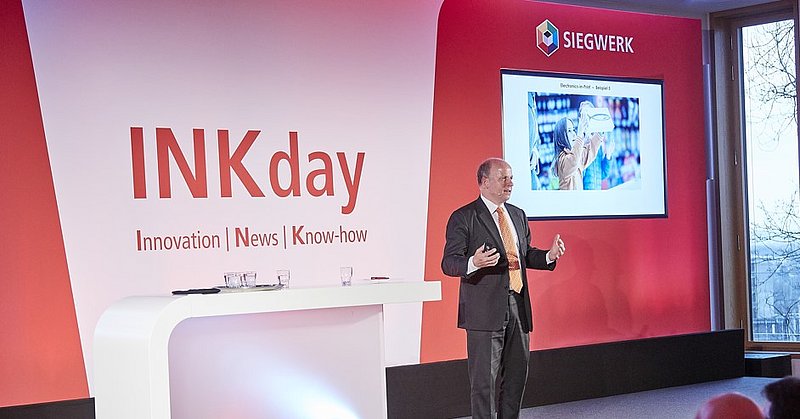
Christian Rommel during his presentation.
Smart Packaging – The future of packaging in an increasingly digital world
Q: How has packaging design changed over the years?
A: If you look at the evolution of packaging from the early days until now, you see that packaging design has undergone an amazing transformation from boring grey boards to special shapes and constructions to unique accessories and closing mechanism up to a wide range of coloring and special effects. And the evolution of packaging design further continues. Today, we mainly see analog packaging combined with all kind of finishing. Whether it is relief printing, lamination, embossing or fragranced pigments the list of possibilities is long when you want to transform a normal piece of paper, film or board into a special packaging. In future, we will additionally see smart packaging as one of the leading packaging technologies worldwide. Experts see smart packaging to become the biggest and fastest growing segment in the packaging industry over the next years.
Q: What makes packaging smart?
A: In general, smart packaging is defined as packaging with several additional features that offer more than simple product protection. Due to the use of special substrates, digital or electronic applications smart packaging performs extended functions and thereby offers a clear added value to the consumer. This added value can either be an external and emotional marketing effect or an innovative and functional additional benefit. Smart packaging follows a multi-sensory approach: It addresses all senses by adding digital and electronic applications to analog packaging. Digital features are for example QR codes, augmented and virtual reality or Bluetooth connection. Electronic applications add things like light, sound, movement and video and in particular cases even temperature and vibration to the packaging. So, smart packaging combines the physical and digital world and serves as transmitter between manufacturer, distributor, consumer, web and social media. All in all, it’s about the intelligent connection of paper, board or film with any kind of microelectronics to make packaging smart.
Q: And how is this microelectronics added to packaging?
A: There are two different areas to add electronics to the packaging: “electronics in print” and “printed electronics”. Classic “electronics in print” packaging integrates physical components and mechanics. It is therefore handcrafted and not producible in-line for larger scale. That’s where “printed electronics” comes into play. It describes electronic components and applications that are completely or partially produced with common printing equipment. In most of the cases organic materials are used to create these electronics, that’s also why “printed electronics” belongs to the field of organic electronics. During the last year, scientists have reached an incredible breakthrough in this area: They developed a technology of organic LEDs (OLED) that will be able to replace the use of today’s LED and electroluminescent technologies in order to light up surfaces of any printed material. The OLED technology is still in R&D stage, but the area already shows high potential.
Q: Aren’t electronics in packaging environmentally unfriendly?
A: Indeed. That’s still the biggest problem. “Electronic in print” packaging with its physical components will always need to be separated from the packaging for appropriate disposure and recycling. Whereas, the new OLED technology as part of “printed electronics” could solve this problem. R&D teams are currently working on making OLED disposable as waste paper. This breakthrough will have a major influence on the future development of smart packaging.
Q: Which role do printing inks play for future packaging?
A: The biggest challenge in smart packaging is the energy that is needed. We need innovative solutions to provide added applications with sufficient energy to enable the features that make a packaging smart. That’s where “printed electronics” come into play. The area of “printed electronics” will play a significant role for the future development of smart packaging. Future printing inks have to support digital and electronic applications in creating an optical result that stands out from the rest. We need to find new ways to print electronics on substrates. With OLED we already have an innovative technology in the front line that will be able to set highlights on any surface. Thus, new challenges will be to develop semitransparent or rather translucent inks and create completely new packaging features by combining them with light, digital applications and backlighting using conductive inks.
Q: What’s the status-quo of smart packaging? Does it already exist?
A: Today, smart packaging is still rare. But in future we will be confronted with smart products in any area of life – no matter if packaging, lifestyle, automobile, fashion or interior design. Going forward, smart products will take more and more roles in our everyday life. If you look at the possibilities we already have today, lots of things would already be technically possible. Interactive packaging for example – packaging of composite materials, board, film, printed with today’s inks on existing equipment combined with digital and programmable surfaces that show personalized content with the aim to interact with the consumer. It is definitively something that we will see in a few years. At least as long as the customer benefit is the decisive factor of the packaging. Because smart packaging only can be successful when the consumer is not seduced to buy a product by cheap effects, but when the consumer feels the added value of the packaging. A balanced mix of marketing effect and functional benefit will be the challenge for this new generation of packaging.